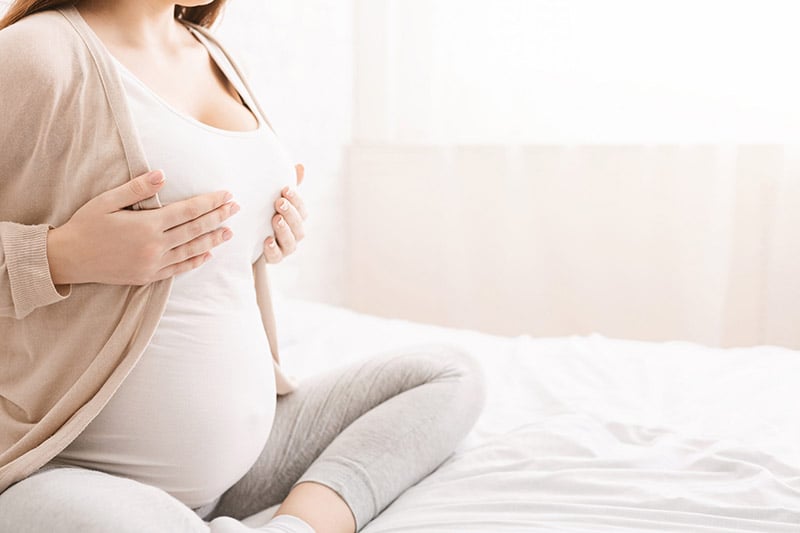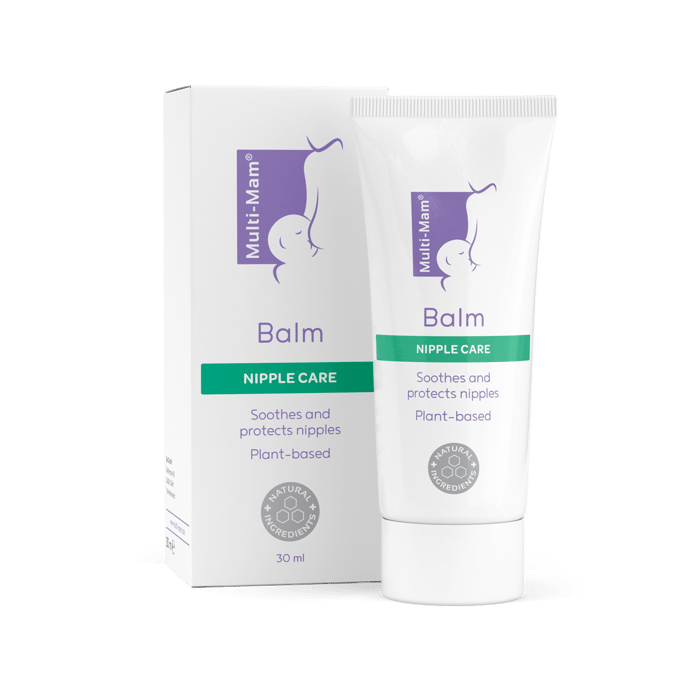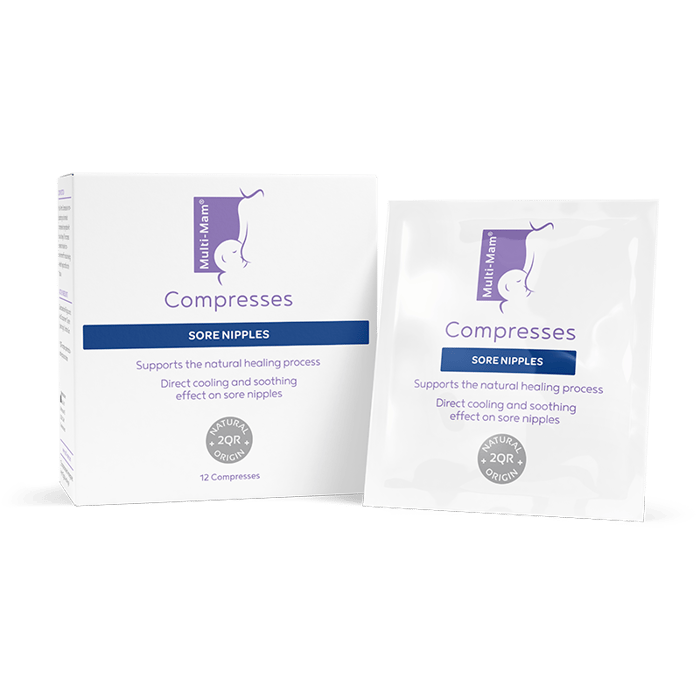Pregnancy Nipple & Breast Pain
The body goes through a lot of changes during pregnancy. The breasts are no exception. Lactation usually begins during the 16th week of pregnancy and can change the shape and size of your breast and nipples. You may experience soreness, tenderness, itchiness, and even pain. Breast and nipple pain during pregnancy is normal and will usually go away on its own. This guide will help you learn what to expect, how to manage swollen sore nipples, and how to reduce breast pain.
Types of breast pain common during pregnancy
You can experience pain in both your breasts and nipples during your pregnancy.
Breast pain during pregnancy
Your breasts will grow during your pregnancy. This growth can leave your breasts feeling achy, full, tender, and even itchy. Your breasts can grow several sizes during your pregnancy as your body prepares to lactate. Buying pregnancy bras that are adjustable and do not have an underwire can help you protect and support your breasts during your pregnancy.
Nipple pain during pregnancy
The nipples also go through a significant change during pregnancy. You may experience pain in one nipple or both nipples. You may also notice a swollen areola, darkening areola, or growing areola. All of this is perfectly normal. Nipples are very sensitive to start with, and the fluctuations due to hormonal changes and lactation can result in pain, dryness, itchiness, and even irritation. If you have sensitive nipples during pregnancy, you will want to reduce irritation and chafing and work to protect the skin barrier around your nipples.

Symptoms of breast pain during pregnancy
Breast pain early pregnancy often feels dull and achy. You may notice your breasts feeling heavy or even swollen. They may even be sensitive. Touching them, exercising, and even wearing tight clothes can all become uncomfortable. While breast pain can occur throughout the breast, those in early pregnancy will likely notice they have sensitive nipples. Sensitive nipples during early pregnancy is common.
Symptoms that are common during pregnancy can include:
Swollen sore nipples
Nipples expand in size, become extra sensitive, and can become easily irritated by movement, what you are wearing, and even because of allergens.
Swollen, sensitive breasts
Your breasts will increase in size as they gear up to produce breastmilk. You may go up one bra size or several during your pregnancy.
Sharp breast pain
Sharp breast pain or a stabbing pain in nipple is not normally a symptom during pregnancy, though it can happen. If it occurs regularly, consistently, or is getting worse, get in touch with your GP.
Causes of breast pain during pregnancy
Breast and nipple pain during pregnancy is due to a variety of factors that change from the first trimester to the second trimester to the third trimester and into breastfeeding.
First trimester
During the first trimester, circulation and blood flow will increase throughout your body, and you will experience hormonal changes.
A few of the symptoms you may notice during your first trimester include:
- The veins on your breasts become more visible, larger, or bluer during this time.
- Your breasts also often grow during the first trimester and feel tender and swollen. These changes are mostly due to hormonal changes, and breast pain due to these hormonal changes tends to naturally decrease within a few weeks as your body adjusts and gets accustomed to the new hormone levels.
- You may notice an ache in your armpits. This is because this area has breast tissue colloquially known as the Tail of Spence.
- Your nipples may get bigger or become more sensitive.
- Your areola may become darker.
- You may also notice small bumps on your areolas. These are called Montgomery tubercles and are glands that provide antiseptic and lubricating benefits.
Second trimester
Oestrogen levels continue to rise during your second trimester. Your breasts will continue to change as your body adjusts and prepares to produce milk. Key changes to your breasts during your second trimester include:
- Your breasts may grow larger. Some may only go up one bra size during this time, others may go up several.
- Your milk ducts will develop further.
- Your body will start to produce colostrum, which is the first form of breast milk.
- You may start to experience leaking or nipple discharge, especially if your nipples are being stimulated.
Third trimester
- Your nipples may become harder, larger, or more pronounced and may even change shape.
- Your nipples and areolas will likely darken further.
After delivery
Your body will start to produce breastmilk in earnest in the few days after you give birth. This can result in symptoms of engorgement. You may also experience sore or puffy nipples when breastfeeding in the beginning until you learn how to breastfeed properly in a way that does not hurt you.
Solutions and treatments for breast pain during pregnancy
There are several solutions and treatments that will help you manage breast and nipple pain during pregnancy.
Use hot and cold therapy
Both warm and cold temperatures can help ease irritation and pain in your breasts during pregnancy. Cold compresses can help ease irritation and soothe aches in your breasts. Cold can also help with nipple pain and swelling. Warm compresses can also help ease aches and can increase circulation.
Keep nipples clean and dry
Soaps can remove the natural oils from your nipples and skin. Avoid using soaps and instead, use water to keep your nipples clean. If you have a red swollen nipple, cracked skin, or irritated breasts, then you will want to clean your nipples instead with a fresh saline solution. This only requires a ½ teaspoon per 250ml of water. Simply soak your nipples in this solution, and then pat dry. Cleaning your nipples like this and keeping them dry can reduce thrush nipple pain and the risk of developing a yeast infection in your nipples.
Get special pregnancy and nursing bras
Irritation and chafing can cause breast tenderness and nipple pain during pregnancy. Ensure you are wearing clothes and bras that fit your new breast size. There are specific pregnancy and nursing bras that can provide extra support and the flexibility to adjust the size and shape of the bra to suit your body’s changes.
You may even want to consider sleeping bras that support your breasts and protect you from nipple chafing while you sleep. These usually come in a wrap style for comfort and flexibility.
When it comes to material, aim for soft, natural fabrics that are supportive without irritation. This usually means avoiding bras that have an underwire.
Nipple creams, balms, and compresses
Nipple balms like Multi-Mam Balsam Protect, Nipple creams like lanolin, and nipple compresses like Multi-Mam Compresses can all work to soothe irritated skin and provide an essential barrier that reduces irritation. The goal is to protect the skin and nipples so that the body can heal.
Pregnancy Nipple & Breast Pain FAQ
How can I reduce nipple pain during pregnancy?
There are many ways that you can reduce nipple pain during pregnancy. You can use cold compresses and pain killers to help alleviate the pain in your boobs.
What trimester do your nipples hurt?
Your nipples and boobs can start to hurt from the first trimester onwards. In the first trimester, your nipples and breasts may hurt because of the influx in hormones, because of the increased blood flow, or because your body is preparing for milk production.
How early will I experience breast and nipple pain during pregnancy?
You may experience breast pain as early as the third or fourth week of pregnancy. Breast and nipple pain this early isn’t due to the lactation process but instead due to massive hormonal changes in your body. The first trimester is when your body ramps up hormone production, particularly oestrogen and progesterone, which can cause breast soreness and other nipple-related irritation and pain.
When does lactation start?
Lactation will start around the 16th week of your pregnancy. This is when colostrum production starts. Colostrum is the nutrient-dense breastmilk infants feed on first.
What other breast changes can I expect during pregnancy?
Pain and soreness are common symptoms of the many changes that your breasts go through during pregnancy. You may also notice that:
- You are larger or more prominent in your breasts.
- Your areolas get darker and may even grow.
- Your areolas may start exhibiting tiny bumps called Montgomery tubercles that work to lubricate your nipples with natural oils.
- First drops of mother milk can leak, if the colour is yellowish it’s usually colostrum.
- You can form stretch marks on your breasts.
Why do I have a lump in my breast?
If you are pregnant or breastfeeding, you may notice a small new lump in your breast. These are usually harmless. If you are pregnant and you notice a lump, then get in touch with your GP or medical doctor. If you are breastfeeding, try to see if directing your infant towards the lump and massaging the area removes it, as it could easily be a blocked breast duct. If this does not work, get in touch with a medical professional immediately, as a blocked duct can develop into mastitis. Mastitis nipple pain and breast pain are usually treated with antibiotics.
Why do I feel an ache in my armpits during pregnancy?
You might feel an ache that travels up into your armpits during pregnancy. This is normal and is because of the breast tissue commonly known as the Tail of Spence.
What do I do if my breasts leak during pregnancy?
Leakage during pregnancy is normal, and you don’t need to worry about accidentally leaking all of your body’s colostrum. The amount you leak is very small. If you are worried about accidentally leaking through your clothes or bra, you can use nursing pads. Avoid stimulating your nipples as well to reduce the chances of breastmilk leaking.
Links & Sources
- https://www.healthline.com/health/pregnancy/pregnant-breast#:~:text=They%20may%20feel%20tender%20and,called%20the%20Tail%20of%20Spence.
- https://www.parents.com/pregnancy/my-body/changing/9-crazy-ways-your-breasts-change-during-pregnancy/



